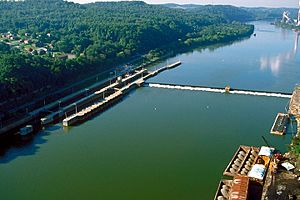- This page was last modified on 17 October 2025, at 10:18. Suggest an edit.
Elizabeth Locks & Dam facts for kids
| Elizabeth Lock and Dam | |
|---|---|
 |
|
| Location | Elizabeth, Pennsylvania and West Elizabeth, Pennsylvania |
| Coordinates | 40°15′54″N 79°54′00″W / 40.265°N 79.900°W |
| Construction began | 1905 |
| Opening date | 1907 |
| Operator(s) | U.S. Army Corps of Engineers, Pittsburgh District |
| Dam and spillways | |
| Impounds | Monongahela River |
The Elizabeth Locks & Dam is a special structure on the Monongahela River in Pennsylvania. It's like a water elevator that helps boats travel safely. This dam is one of nine similar structures along the river. These structures help boats move between Pittsburgh and Fairmont, West Virginia.
The U.S. Army Corps of Engineers built and takes care of this dam. It creates a long, calm section of water upstream. This section stretches for about 23.8 miles, reaching all the way to Charleroi, Pennsylvania.
Elizabeth Locks & Dam: Helping Boats Travel
The Elizabeth Locks & Dam is a very important part of river travel. It helps boats, like barges carrying goods, move up and down the Monongahela River. Without it, the river would have too many shallow spots or fast currents.
A "lock" is like a chamber that fills with or empties water. This allows boats to go up or down to different water levels. The "dam" holds back water to create a deeper, more stable river section.
Who Built and Runs It?
The United States Army Corps of Engineers is a group that builds and maintains many important structures. They are in charge of the Elizabeth Locks & Dam. They make sure it works well for everyone using the river.
Construction on the dam started in 1905. It was finished and opened for use in 1907. This means it has been helping boats for over a hundred years!
What Does It Do?
The Elizabeth Locks & Dam is located at mile 23.8 on the Monongahela River. Its main job is to keep the river deep enough for boats to pass. It also helps control the water level.
In 1979 and 1980, the dam went through a big update. This project made it more modern and efficient. It continues to play a key role in river transportation today.
